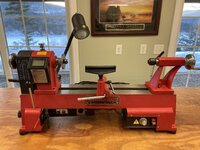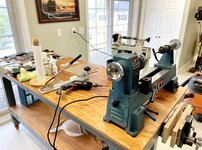The headstock of a Turncrafter lathe is attached to the bedways by means of four screws. Alignment can be checked by advancing the tailstock with a cone live center until its tip touches the point of a driver center in the headstock. My experience was that the headstock and tailstock alignment was bang-on in the vertical direction out of the box. However, since I had to install the headstock, it was necessary for me to check and tweak the alignment in the horizontal plane.
William Thompson (Lord Kelvin) once said "I often say that when you can measure what you are speaking about, and express it in numbers, you know something about it: but when you cannot express it in numbers, your knowledge is of a meager and unsatisfactory kind; it may be the beginning of knowledge, but you have scarcely, in your thoughts, advanced to the stage of a science, whatever the matter may be."
So let's put some numbers on the matter of the loose tailstock. As shown below, the tailstock has a protrusion machined on its bottom that fits between the two bedways of the lathe and that aligns the tailstock to the bedways.
View attachment 239932
The problem is this the fit between the tailstock and bedways is very slightly loose, and as a result, the tailstock can 'swivel' a fraction of a degree when it is not locked down, thereby distorting slightly the alignment in the horizontal plane.
The measurements I made on my 12" Turncrafter are that the protrusion on the bottom of the tailstock is 31.8mm wide, while the spacing between the bedways is about 32.8mm wide. I remembered enough high school trig to calculate that could allow the tailstock to swivel as much as +/- 0.3 degrees (total rotation of 0.6 degrees). That's not a lot, but the issue is how much lateral deviation can this cause between the headstock axis, and the axis of the tailstock, and that deviation increases as the tailstock ram is extended, and even more when a drill bit is installed in a jacobs chuck in the tailstock.


